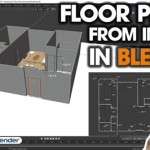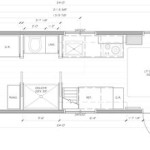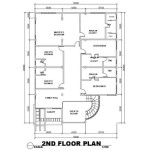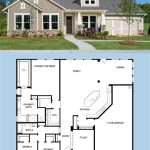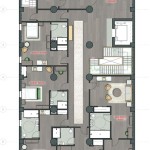How to Draw a One-Bedroom Floor Plan
Creating a one-bedroom floor plan is a fundamental skill for architects, interior designers, real estate professionals, and even individuals planning renovations or envisioning a new living space. A well-drawn floor plan provides a visual representation of the layout, allowing for effective space planning, furniture arrangement, and communication of design ideas. This article outlines a step-by-step guide to drawing a one-bedroom floor plan, covering essential considerations and techniques.
Before initiating the drafting process, it is crucial to gather accurate measurements of the intended space. This involves measuring the length and width of each wall, as well as the positions and dimensions of doors, windows, and any existing architectural features. Precise measurements are fundamental for creating a floor plan that accurately reflects the actual space. Inaccurate measurements will result in a skewed representation and can lead to problems during construction or renovation.
There are two primary methods for creating floor plans: manual drafting and digital drawing using computer-aided design (CAD) software. Manual drafting involves using drafting tools such as rulers, set squares, compasses, and pencils to create the plan on paper. CAD software offers a digital alternative, enabling the creation of precise and easily modifiable floor plans on a computer. The choice between these methods depends on individual preference, existing skills, and the complexity of the project. Digital drafting offers greater flexibility for revisions and collaboration.
Understanding Scale and Conventions
Scale is a critical aspect of floor plan drawing. It represents the ratio between the dimensions on the drawing and the actual dimensions of the space. A common scale for residential floor plans is 1/4 inch = 1 foot, meaning that every quarter inch on the drawing represents one foot in the real world. Choosing an appropriate scale ensures that the entire floor plan fits comfortably on the drawing surface while maintaining sufficient detail.
Standard conventions are used in floor plans to represent different elements, such as walls, doors, windows, and fixtures. Walls are typically depicted as thick lines, while doors are represented as an arc indicating the direction of swing. Windows are usually shown as two parallel lines within the wall thickness. Plumbing fixtures, appliances, and electrical outlets also have standardized symbols to ensure clarity and consistency across different floor plans.
Familiarizing oneself with these conventions is crucial for both creating legible floor plans and interpreting those created by others. Failure to adhere to standard conventions can lead to misinterpretations and errors in communication.
Steps for Drawing a One-Bedroom Floor Plan
The initial step involves sketching the exterior walls of the one-bedroom apartment. Using the gathered measurements and chosen scale, accurately represent the shape and dimensions of the exterior walls. Ensure that the corners are square and the lines are straight. If using CAD software, utilize the line tool and input the precise distances to create the walls. With manual drafting, use a ruler and set square to achieve accuracy.
The next step is to indicate the interior walls that define the different rooms within the apartment. This includes the walls separating the bedroom, living area, kitchen, and bathroom. Consider the desired layout and functionality of each space when determining the placement of interior walls. Maintain consistent wall thickness throughout the plan.
After establishing the walls, doors and windows are added. Indicate the location and size of each door and window. Use the appropriate symbols for doors, showcasing the direction of swing. Ensure the windows are positioned logically to provide adequate natural light and ventilation. Measure the door openings and window widths accurately from the original measurements. The placement of doors should consider traffic flow and furniture placement.
Once the structural elements are in place, focus on adding essential fixtures and appliances. This includes the bed, closet in the bedroom, sofa, table, and chairs in the living area, kitchen appliances such as the refrigerator, stove, and sink, and bathroom fixtures like the toilet, sink, and shower or bathtub. Drawing these fixtures to scale and placing them thoughtfully helps to visualize the use of space and ensure that there is adequate room for movement.
In the kitchen, accurately represent the placement of cabinets and countertops according to desired dimensions. Consider the ergonomic principles of kitchen design to facilitate efficient workflow. The placement of appliances should be integrated with the overall design and consider electrical and plumbing connections. In the bathroom, correctly position the toilet, sink, and shower or bathtub, accounting for plumbing requirements and accessibility. Sufficient clearance space around each fixture is necessary for comfortable use.
Finally, add dimensions and annotations to the floor plan to provide clarity and context. Label each room with its name (e.g., Bedroom, Living Room, Kitchen, Bathroom). Add dimensions to indicate the length and width of each room, as well as the overall dimensions of the apartment. Annotate any specific features or details that are relevant to the design, such as the type of flooring or the location of electrical outlets.
Key Considerations for One-Bedroom Floor Plans
Optimizing space is critical in a one-bedroom apartment. Efficient space planning involves maximizing the usable area while maintaining a comfortable and functional layout. Consider multi-functional furniture, such as sofa beds or storage ottomans, to make the most of limited space. Vertical storage solutions, like shelves and cabinets that extend to the ceiling, can also help to increase storage capacity without taking up valuable floor space.
Traffic flow refers to the way people move through the apartment. A well-designed floor plan should minimize obstructions and create a smooth and intuitive flow between rooms. Avoid placing furniture in pathways or creating awkward corners that hinder movement. Ensure that there is ample space around furniture and fixtures to allow for comfortable passage.
Natural light and ventilation are vital for creating a pleasant and healthy living environment. Position windows strategically to maximize the amount of natural light that enters the apartment. Consider the orientation of the building and the direction of sunlight when determining window placement. Ensure that there is adequate ventilation to prevent moisture buildup and maintain air quality. Cross-ventilation, achieved by placing windows on opposite sides of the apartment, can help to improve airflow.
While manual drafting provides a hands-on approach and can be suitable for simple floor plans, CAD software offers numerous advantages for more complex projects. CAD software allows for precise drawing, easy modification, and the ability to create 3D models of the floor plan. It also facilitates collaboration and communication with other professionals involved in the project. Popular CAD software options include AutoCAD, Revit, and SketchUp.
Reviewing and refining the floor plan is an essential final step. After creating the initial floor plan, carefully review it to identify any potential issues or areas for improvement. Consider the functionality of each space, the flow of traffic, and the placement of furniture and fixtures. Make any necessary adjustments to ensure that the floor plan meets the needs and preferences of the occupants. It may be helpful to seek feedback from others, such as friends, family members, or design professionals, to gain different perspectives and identify potential blind spots.
The complexity of the floor plan needs to be considered. A complex floor plan can incorporate detailed architectural elements, such as arches, columns, or built-in features. It may also include multiple levels or non-standard room shapes. Drawing a complex floor plan requires more advanced drafting skills and attention to detail. Simpler floor plans are characterized by straightforward layouts and minimal architectural embellishments. These plans are typically easier to draw and may be suitable for smaller or more basic apartments. The level of detail and complexity of the floor plan should be appropriate for the intended use. For example, a floor plan intended for construction purposes will require more detail than a floor plan used for preliminary design brainstorming.

Ground Floor Plan Of One Bedroom Bungalow Scientific Diagram

Floor Plans Learn How To Design And Plan

1 Bedroom Apartment Plan Examples

1 Bedroom House Plan Examples

Archimple 10 Tips To Make Your Own 1 Bedroom Guest House Floor Plans

Free Editable Apartment Floor Plans Edrawmax

1 Bedroom House Plan Examples

1 Bedroom House Plan Examples

How To Make A One Bedroom Apartment Work For Family Lifeedited

How To Make A One Bedroom Apartment Work For Family Lifeedited
Related Posts

